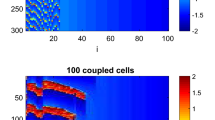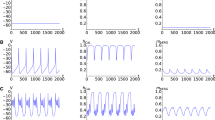Abstract
I seek to explain phenomena observed in simulations of populations of gap junction-coupled bursting cells by studying the dynamics of identical pairs. I use a simplified model for pancreatic β-cells and decompose the system into fast (spike-generating) and slow subsystems to show how bifurcations of the fast subsystem affect bursting behavior. When coupling is weak, the spikes are not in phase but rather are anti-phase, asymmetric or quasi-periodic. These solutions all support bursting with smaller amplitude spikes than the in-phase case, leading to increased burst period. A key geometrical feature underlying this is that the in-phase periodic solution branch terminates in a homoclinic orbit. The same mechanism also provides a model for bursting as an emergent property of populations; cells which are not intrinsic bursters can burst when coupled. This phenomenon is enhanced when symmetry is broken by making the cells differ in a parameter.
Similar content being viewed by others
Literature
Abbott, L. F. and G. LeMasson. 1993. Analysis of neuron models with dynamically regulated conductances.Neural Comput. 5, 823–842.
Aronson, D. G., G. B. Ermentrout and N. Kopell. 1990. Amplitude response of coupled oscillators.Physica 41D, 403–449.
Ashkenazi, M. and H. G. Othmer. 1978. Spatial patterns in coupled biochemical oscillators.J. math. Biol. 5, 305–350.
Chay, T. R. and D. L. Cook. 1988. Endogenous bursting patterns in excitable cells.Math. Biosci. 90, 139–153.
Chay, T. R. and J. Keizer. 1983. Minimal model for membrane oscillations in the pancreatic β-cell.Biophys. J. 42, 181–190.
Doedel, E. 1981. AUTO: a program for the automatic bifurcation analysis of autonomous systems.Cong. Num. 30, 265–284.
Ermentrout, B. 1990.Phase Plane: The Dynamical Systems Tool Version 3.0. Pacific Grove, CA: Brooks/Cole.
Ermentrout, G. B. 1985. The behavior of rings of coupled oscillators.J. math. Biol. 23, 55–74.
Fairgreave, T. F. and A. D. Jepson. 1991. O. K. Floquet multipliers.SIAM J. numer. Anal. 28, 1446–1462.
Fitzhugh, R. 1961. Impulses and physiological states in theoretical models of nerve membrane.Biophys. J. 1, 445–466.
Gear, C. W. 1967. The numerical integration of ordinary differential equations.Math. Comput. 21, 146–156.
Gembal, M., P. Gilon and J.-C. Henquin. 1992. Evidence that glucose can control insulin release independently from its action on ATP-sensitive K+ channels in mouse B cells.J. clin. Invest. 89, 1288–1295.
Halban, P. A., C. B. Wollheim, B. Blondel, P. Meda, E. N. Niesor and D. H. Mintz. 1982. The possible importance of contact between pancreatic islet cells for the control of insulin release.Endocrinology 111, 86–94.
Hansel, D., G. Mato and C. Meunier. 1993. Phase dynamics for weakly coupled Hodgkin-Huxley neurons.Europhys. Lett. 23, 367–372.
Himmel, D. and T. R. Chay. 1981. Theoretical studies on the electrical activity of pancreatic β-cells as a function of glucose.Biophys. J. 51, 89–107.
Hindmarsh, A. 1974. An ordinary differential equation solver. Report UCID-39991, Lawrence Livermore Laboratory.
Hindmarsh, J. and M. Rose. 1984. A model of neuronal bursting using three coupled first order differential equations.Proc. R. Soc. (Lond.) B221, 87–102.
Kawato, M., M. Sokabe and R. Suzuki. 1979. Synergism and antagonism of neurons caused by an electrical synapse.Biol. Cybern. 34, 81–89.
Keizer, J. and G. Magnus. 1989. ATP-sensitive potassium channels and bursting in the and voltage-inactivated Ca2+ channels.Proc. natn. Acad. Sci. U.S.A. 88, 3897–3901.
Kuramoto, Y. 1984.Chemical Oscillations, Waves, and Turbulence. Berlin: Springer.
Lewis, E. R. 1968. Synchronization in small groups of neurons: a study with electronic models. InCybernetic Problems in Bionics, H. L. Oestreich (Ed.), pp. 777–789. New York: Gordon and Breach.
Meissner, H. P. and H. Schmelz. 1974. Membrane protential of beta-cells in pancreatic islets.Pfluegers Arch. 351, 195–206.
Morita, Y. 1986. A secondary bifurcation problem of weakly coupled oscillators with time delay.Jap. J. appl. Math. 3, 223–247.
Morita, Y. 1987. A periodic wave and its stability to a circular chain of weakly coupled oscilators.SIAM J. math. Anal. 18, 1681–1698.
Morris, C. and H. Lecar. 1981. Voltage oscillations in the barnacle giant muscle fiber.Biophys. J. 35, 193–213.
Pernarowski, M., R. M. Miura and J. Kevorkian. 1992. Perturbation techniques for models of bursting electrical activity in the pancreatic β-cells.SIAM J. appl. Math. 52, 1627–1650.
Rinzel, J. 1985. Bursting oscillations in an excitable membrane model. InOrdinary and Partial Differential Equations, B. D. Sleeman and R. J. Jarvis (Eds), pp. 304–316. New York: Springer.
Rinzel, J. 1987. A formal classification of bursting mechanisms in excitable systems. InMathematical Topics in Population Biology, Morphogenesis, and Neurosciences, E. Teramoto and M. Yamaguti (Eds), Lecture Notes in Biomathematics 71, pp. 267–281. New York: Springer.
Rinzel, J. and G. B. Ermentrout. 1989. Analysis of neural excitability and oscillations. InMethods in Neuronal Modeling, C. Koch and I. Segev (Eds), pp. 135–169. Cambridge, MA: MIT Press.
Rinzel, J. and Y. S. Lee. 1986. On different mechanisms for membrane potential bursting. InNonlinear Oscillations in Biology and Chemistry, H. G. Othmer (Ed.), Lecture Notes in Biomathematics 66, pp. 19–33. New York: Springer.
Rinzel, J., A. Sherman and C. L. Stokes. 1992. Channels, coupling, and synchronized rhythmic bursting activity. InAnalysis and Modeling of Neural Systems, F. Eeckman (Ed.), pp. 29–46. Boston: Kluwer.
Santos, R., L. Rosario, A. Nadal, J. Garcia-Sancho, B. Soria and M. Valdeolmillos. 1991. Widespread synchronous Ca2+ oscillations due to bursting electrical activity in single pancreatic islets.Pfluegers Arch. 418, 417–422.
Sherman, A. and J. Rinzel. 1991. Model for synchronization of pancreatic β-cells bygap junction coupling.Biophys. J. 59, 547–559.
Sherman, A. and J. Rinzel. 1992. Rhythmogenic effects of weak electrotonic coupling in neuronal models.Proc. natn. Acad. Sci. U.S.A. 89, 2471–2474.
Sherman, A. and H.-R. Zhu. 1994. Anti-phase, asymmetric, and aperiodic oscillations in electrically active cells. II. Fast sub-system. In preparation.
Sherman, A., J. Rinzel and J. Keizer. 1988. Emergence of organized bursting in clusters of pancreatic β-cells by channel sharing.Biophys. J. 54, 411–425.
Smolen, P. and J. Keizer. 1992. Slow voltage inactivation of Ca2+ currents and bursting mechanisms for the mouse pancreatic β-cell.J. Membr. Biol. 127, 9–19.
Smolen, P., J. Rinzel and A. Sherman. 1993. Why pancreatic islets burst but single β cells do not: the heterogeneity hypothesis.Biophys. J. 64, 1668–1680.
Somers, D. and N. Kopell. 1993. Rapid synchronization through fast threshold modulation.Biol. Cybern. 68, 393–407.
Taylor, M. A. and I. G. Kevrikidis. 1991. Some common features of coupled oscillatory reacting systems.Physica 51D, 274–292.
Terman, D. 1992. The transition from bursting to continuous spiking in excitable membrane models.J. Nonlinear. Sci. 2, 135–182.
Wang, X.-J. 1993. Genesis of bursting oscillations in the Hindmarsh-Rose model and homoclinicity to a chaotic saddle.Physica 62d, 263–274.
Wiggins, S. 1990.Introduction to Applied Nonlinear Dynamical Systems and Chaos. New York: Springer.
Author information
Authors and Affiliations
Rights and permissions
About this article
Cite this article
Sherman, A. Anti-phase, asymmetric and aperiodic oscillations in excitable cells—I. Coupled bursters. Bltn Mathcal Biology 56, 811–835 (1994). https://doi.org/10.1007/BF02458269
Received:
Revised:
Issue Date:
DOI: https://doi.org/10.1007/BF02458269




